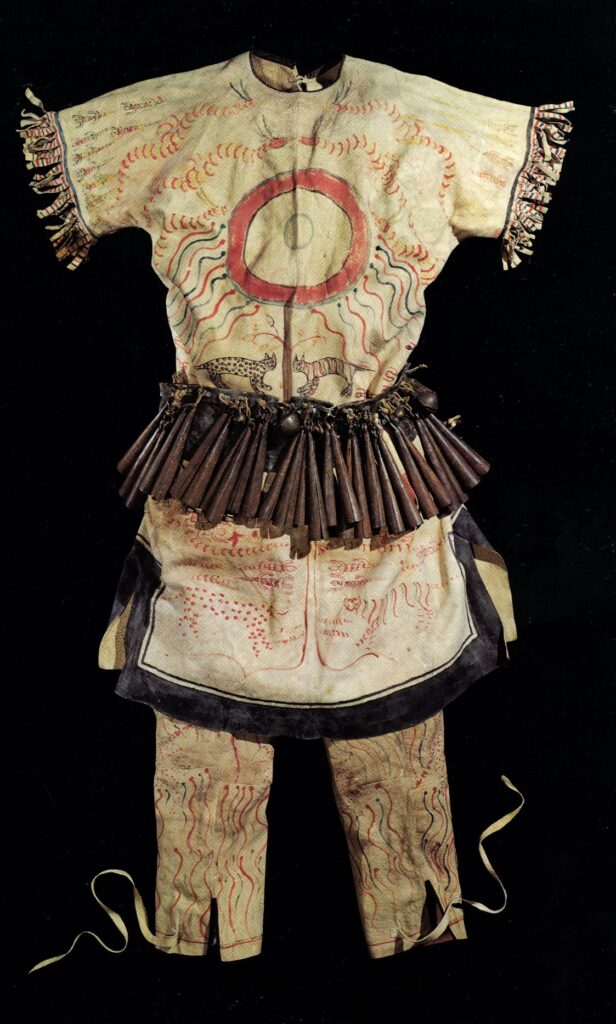PRESENTED BY

Shamanism is a set of knowledge, beliefs and traditional activities practiced by the shaman, a specialist capable of entering a trance to travel to other realms or realities. Aided by his spirit allies and objects of power, such as costumes, musical instruments, amulets, weapons, inhalers, pipes and trance-inducing substances, the shaman diagnoses and cures ills, divines and predicts the future to solve critical situations experienced by the individuals and the community.
The exhibition has been curated by the art historian Constantino Manuel Torres, who has spent more than 40 years studying this interesting topic of history, art and anthropology. Mapuche shamanism has a prominent place in the exhibition, curated by the researcher Juan Ñanculef Huaiquinao, a specialist in the tradition and ancestral wisdom of his people.
There are approximately 140 archaeological and ethnographic objects and audiovisual documents, representative of continental shamanism, from North America to Tierra del Fuego. Through their shapes, materials, images and their ability to inspire contemporary artists, these objects establish a fascinating relationship between shamanism and art.
The Tree of Life
or Axis Mundi.
───
A Siberian
shaman outfit.
───
In the shamanic cosmology of many cultures of the world, the universe is conceived as multi-layered: heaven, earth and the underworld are the most common, although there may be many more. In most cases, these layers are linked by an axis that is represented by the image of a tree. This shamanic metaphor allows for a non-linear arrangement of the world, to unify the cosmos and to travel. This multilevel cosmos can be navigated as it is linked by this axis, by the Tree of Life or the Cosmic Tree. Travel as the preeminent shamanic activity encompasses the other components of shamanism: accumulation, transformation, ecstatic flight, receiving helpers and allies, and healing individuals and the community.
The clothing of a Siberian shaman is a representation of the shamanic worldview. Part of it is armor. The objects that hang from his waist allow him to acquire qualities of animals, plants and mushrooms facilitate the ability to see and communicate with beings from different kingdoms. Many of them have a direct connection to specific ailments and how to cure them. These helpers and allies incorporated into the suit play a role in conflict resolution, such as catching thieves, bringing prosperity or healing, among other acts. Clothing is thus a living organism.
Árbol que crece en el inframundo
(Detalle en la chaqueta del traje).
Árbol que crece en el centro de la tierra.
(Anverso del traje).
Árbol que crece en el cielo.
(Reverso del traje).
PRESENTED BY



TEMPORARY EXHIBITION
DECEMBER 2022 – JUNE 2023
The Cleveland Museum of Art,
Ohio, EEUU.
Museo Larco,
Lima, Perú
Stad Ulm-Museum Ulm,
Ulm, Alemania
Museo Nacional de Historia Natural,
Chile
Museo Histórico Nacional,
Chile
Fundación Desierto de Atacama,
San Pedro de Atacama, Chile
José Bedia, EEUU
Stacy Schaefer, EEUU
Constantino Manuel Torres, EEUU
Donna Torres, EEUU
William Maguire, EEUU
Juan Salinas Lyon, Chile
Cristián Undurraga, Chile
Francisco Gallardo, Chile
Colección Apelles, Chile


Constantino Manuel Torres
Juan Ñanculeff Huaiquinao
Carole Sinclaire, MChAP
Museo Chileno de Arte Precolombino
MESS
Director creativo, diseño y curador asesor, Rodrigo Tisi
Producción y desarrollo de diseño, Tomás Soto
Iluminación, Antonia Peon-Veiga
Diseño gráfico, Renata Tesser y Magdalena Derosas (Enhorabuena Estudio)
Producción gráfica, Gerson Reyes (Lemond)
Impresión en vidrio, José Luis Cabello (Expresionarte)
Videos, Claudio Mercado (MChAP) y Rodrigo Tisi
Grabación y edición video 360, Rodrigo Tisi, Otracosaestudio
Post-producción de videos, Cristóbal Roselllo, Esteban Rojas, Martín Vega, Nicolás Jorquera (Hype Innovation Center)
Montaje equipos audiovisuales, Diego Sepúlveda (SPLVD)
Armado de vitrinas MChAP, Jorge Galaz
Botánica acceso exposición, Fernando Ocampo (theplantstore)
Construcción, Piero Mangiamarchi, Felipe Rivera, John Jardumene y Michelet Lorcy (Constructora Mabo)
Conservación y montaje de colecciones museológicas, Andrés Rosales y Anja Stabler
Joan Donaghey
Daniela Mahana
La identidad gráfica de la exposición se basa en fotografías de microscopía láser de barrido de las especies Anadenanthera colubrina y Trichocereus pachanoi, de los autores Jill Pflugheber and Steven F. White© 2022, obtenidas en St. Lawrence University’s Microscopy and Imagery Center para “Microcosms: A Homage to Sacred Plants of the Americas”
Microcosmssacredplants.org
La identidad gráfica de la exposición se basa en fotografías de microscopía láser de barrido de las especies Anadenanthera colubrina y Trichocereus pachanoi, de los autores Jill Pflugheber and Steven F. White© 2022, obtenidas en St. Lawrence University’s Microscopy and Imagery Center para “Microcosms: A Homage to Sacred Plants of the Americas”
Microcosmssacredplants.org
Sitio web diseñado y desarrollado por Isidora Jiménez y Renata Tesser (Enhorabuena Estudio, enhorabuenaestudio.com).
Desarrollo web por Nicolás Hormazábal (Soluciones en Línea, solucionesenlinea.cl)
Horario
Martes a domingo
10 a 18 horas
Martes a domingo, 10 a 18 horas
Ubicación
Bandera 361
Santiago, Chile
Bandera 361, Santiago, Chile
Apoyo Institucional


Río Amur, Siberia, ca. 1880.
Colección American Museum of Natural History, New York, Nº 70/696.
(Foto, en J.M. Vastokas, 1974. The shamanic tree of life. Society for Art Publications, Canada, p.184).